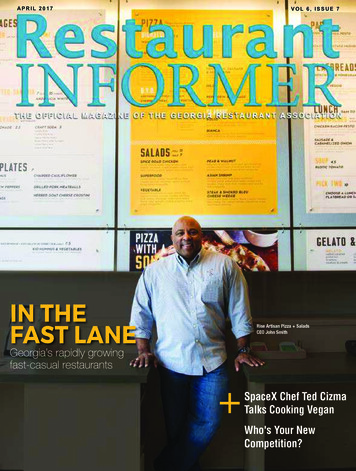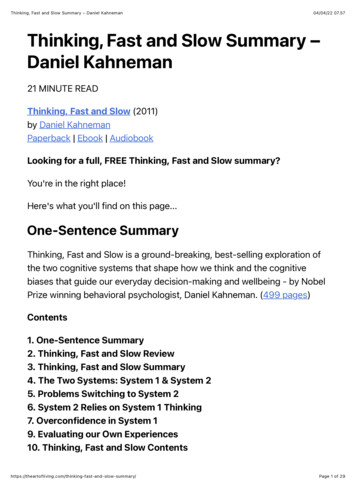
Transcription
APRIL 2017VOL 6, ISSUE 7IN THEFAST LANERise Artisan Pizza SaladsCEO John SmithGeorgia’s rapidly growingfast-casual restaurants SpaceX Chef Ted CizmaTalks Cooking VeganWho's Your NewCompetition?RestaurantINFORMER.com 1
Join Gas South for an awesome Shindig on March 23rd at SweetWater Brewing Company! Enjoy food,beer & music while helping us to raise funds for Gas South’s 6th Annual Charity Cornhole Challengethat will take place at the 2017 SweetWater 420 Fest on April 23rd at Centennial Olympic Park.Follow us on Twitter and Facebook for updates and information!Follow us:#GScornhole
Contents14April 2017DEPARTMENTS348102324Editor’s NoteGRA NewsQuick BitesACF Update18Industry EventsRestaurant ReportFEATURES61418Serving Up DollarsAs one of the state’s largest employers, Georgiarestaurants deliver a significant economic impact.4In the Fast LaneBy Hope S. PhilbrickFast-casual restaurants went mainstream in the2000s, and now it’s the most rapidly growingsegment of the restaurant industry.20Cooking with Plants: A Q&A withSpaceX Chef Ted CizmaBy JL FieldsFood FightsBy Nancy CaldarolaThere’s competition on all sides for today’srestaurant industry, so how do you staycompetitive and capture your piece of theconsumer food dollar pie? Plus, 9 must-dos tokeep your restaurant clean.Whether it’s for environmental, ethical or healthreasons, more people are choosing to eat plantbased meals – even if they aren’t vegan sevendays of the week.Publisher: John SawyerEditor: Christy SimoGraphic Designer: Scott BagleyContributing Writers: Karen Bremer,Nancy Caldarola, JL Fields,Hope S. PhilbrickAbout the Cover: Sarah Newmanphotographed Rize Artisan Pizza SaladsCEO John Smith at the restaurant’s Atlantalocation in Poncey-Highland.Restaurant INFORMER is the officialmagazine of the Georgia RestaurantAssociation and is published bySawyer Direct, LLC at P.O. Box 49053,Colorado Springs, CO 80949. 2017 by Sawyer Direct LLC. All rights reserved.For subscription or advertisinginformation, call 719.599.7220 oremail info@restaurantinformer.comRestaurantINFORMER.com 1
Don’t have an IT department?We Are Your Full-Service POSSource from Beginning to EndRDS. We Do ThatSeamless Integrations UsingInterconnect Cloud TechnologyAcross Multiple Platforms.Business Analysis &Solution Development.RDS. WE DO THATGarry EasterlingSales DirectorGEasterling@rdspos.com678-279-8041Veronica ListerInside SalesVLister@rdspos.com678-279-8054We can help with that.IT Solutions for Large & Small Restaurants.Seamless Integrations Using Interconnect CloudTechnology Across Multiple Platforms.Encrypted Transactions for PCI Compliance.Skilled Help Desk Support 24/7/365.Unmatched Pricing for Hardware and Software.RDS. WE DO THATRetail Data Systems is your sourcefor the well-designed POS system.We create custom integrationsusing a comprehensive list of topquality hardware and softwareproducts to strengthen yourprocesses and your bottom line. In25 offices across the country, ourteam of over 400 IT professionals isdedicated to your success.rdspos.com
BriskBUSINESSFresh. Vibrant. Global. Local. These are words you may nothave always associated with the food served at fast-casualrestaurants, yet these are some of the ways today’s concepts arekeeping pace with the larger food trends steering diners’ dollars.While fast-casual is one of the smallest subsets of restaurants– only about 7.5 percent of market share – growth in theindustry has been more than 500 percent since 1999. In fact,while the restaurant industry as a whole grew 5.7 percent in2015, revenue grew 10.4 percent for fast-casual restaurants.So what started out as a slightly elevated version of fast-foodback in the ’90s has now become the country’s fastest-growingsegment of the restaurant industry, due in no small part togiving people what they want.Today that means quality food, but fast. We have things todo. We want healthy foods, but not at a cost that will break ourbudgets. We want the experience of eating out, but we wantefficiency, too.In short, the segment is a reflection of the changing natureof what it means to eat and what restaurants represent to ourculture. While every type of dining establishment has its owntarget audience, taking a look at how the fast-casual marketis responding to changing eating patterns can only help yourbusiness succeed in an ever more demanding industry.So Restaurant Informer did just that, profiling four ofthe state’s fast-casual concepts and showing how they’re areflection of the industry as a whole. You can find Hope S.Philbrick’s article, “In the Fast Lane,” on page 14.Keeping up with where the restaurant industry is going alsomeans knowing who your competition is and what you need todo to keep diners coming through your doors. Our longtimecontributor Nancy Caldarola shares some of the new playersin the field and 9 must-dos to keep your restaurant clean,something that's always important but even more so in today'sdining climate.Lastly, one of the significant trends forecasted by foodconsultants is a bigger emphasis on vegetables. We talk withSpaceX Chef Ted Cizma on page 18 about cooking plant-basedmeals, even if you aren’t vegan yourself.And speaking of trends for 2017, guess what’s No. 2 onthe National Restaurant Association’s list of Top 10 ConceptTrends? Chef-driven fast-casual concepts. Looks like everyoneis getting into the fast lane.Christy SimoEditorRestaurantINFORMER.com 3
NEWSMESSAGE FROM THE CEOA Focus on Workforce DevelopmentThe restaurant industry is in the people business. We are only as good asthe people that we employ in our restaurants, and our employees are our biggestasset. It is important from an associationstandpoint that the Georgia RestaurantTHANK YOUto the following members fortheir continued support!360 Brands LLC dba Freight Kitchen and TapAmiciArnall Golden Gregory LLPBarteca dba Barcelona Atlanta Wine Bar& Restaurant and BartacoBhojanicCarr, Riggs & Ingram, LLCChef Rob’s Caribbean CaféCinco Restaurants, including After FiveFoxhall Resort and Sporting ClubHeirloom Kitchen & Bar, Inc.dba Seed Kitchen & Bar/Sip Wine BarHMS HostJinton Enterprises LLC dba SubwayKabat Chapman & Ozmer LLPLanier Islands dba Sidney’sLe Thai, lnc. dba L’Thai organicCuisine & Wine BarLive Oak Restaurant GroupMagnolia Room CafeteriaMediterraneaMy Menu PalProof of the PuddingRoyal Cup Coffee, Inc.S&D Coffee & TeaSavannah Riverboat CruisesSunburst EnvironmentalThe BarrelhouseTracy’s Tasties mini cheesecakesUnitedHealthcareVaruni NapoliWells Fargo4 Restaurant INFORMER April 2017Association (GRA) focuses on workforcedevelopment initiatives to enhance theeconomic stability of not only the restaurant industry, but also for our community.The restaurant industry is currentlyfacing a labor shortage. Recruiting andretaining top talent remains to be a topchallenge for operators. There is so muchcompetition among other industries foremployees. Workforce demographicsare shifting as the younger labor pool isshrinking, and there is a greater proportion of older workers.On the other hand, there are peopleout there who are unemployed, dislocated workers or low-income adults andyouth. Through workforce developmentprograms, we can seek to improve thejob training and marketability of Georgia’s workforce while helping the restaurant industry create a solution for laborshortages. The GRA is involved in severalinitiatives to create solutions for both employers and potential employees.Kennesaw State University (KSU) offersan excellent culinary program to studentsinterested in the culinary arts. Not everystudent is interested or financially able toattend a four-year program, yet they mayhave a passion for the culinary arts andfor getting a job within the restaurantcommunity. KSU’s program is based onfour hours of classroom per week coupledwith 15 hours in that same week workingin an established restaurant or cateringfacility. Each student completes four seven-week apprenticeships to successfullycomplete the course. Classroom study isimmediately put to practice so that theknowledge and skill base stays with thestudent throughout the program.United Youth of America is a non-profit organization servicing the needs ofunderprivileged young people, ages 7 to17. This organization works with several counties throughout Georgia to placestudents in paid apprenticeship programs. The county agrees to cover a certain amount of the wages and labor taxesduring a six-month period.Westside Works Culinary Academy isa partnership between Westside Works,Levy Restaurants and the Arthur BlankFoundation. This eight-week culinaryacademy introduces students to kitchensafety protocols, international cuisines,baking and pastry and restaurant simulations and provides an opportunity toreceive ServeSafe Certification. Graduateswill have a path to employment throughLevy Restaurants venues, as well as diningestablishments throughout metro Atlanta.The GRA believes that these programswill create opportunities and a brighterfuture for job seekers. The restaurantindustry will be able to employ a disciplined,dynamic, dedicated and well-trained groupof workforce professionals. We want tohelp bridge the gap between talent-readyparticipants and employers that seek toprovide a pathway to a good career.Sincerely,Karen Bremer,CAE, CEOGeorgia RestaurantAssociation
2017 Board of Directors and GRA StaffGeorgia Restaurant Association StaffExecutive CommitteeKaren I. Bremer, CAE, CEOYvonne Morgan, Executive AssistantKatie Jones, Public Affairs CoordinatorDaniel New, Public Affairs AssistantRyan Costigan, Director of MembershipTandelyn Daniel, Member Development ExecutiveRachel Bell, Director of Marketing & CommunicationsMelissa Ledford, Marketing CoordinatorChair - Brian Bullock, Legacy Ventures RestaurantsVice Chair – Kelvin Slater, Slater Hospitality, LLCdba Nine Mile Station - Skyline ParkSecretary - Archna Becker, Bhojanic OwnerTreasurer - Perry McGuire, Smith, Gambrell & Russell, LLPPast Chair - Paul Baldasaro, Home Grown Industries ofGeorgia, Inc. dba Mellow MushroomCEO - Karen Bremer, CAE, Georgia Restaurant AssociationBoard of DirectorsAdvisory BoardPatrick Cuccaro, Affairs to Remember CaterersPhilip Hickey, Miller’s Ale HousePano Karatassos, Buckhead Life Restaurant GroupAlan LeBlanc, Brewed to Serve Restaurant GroupGeorge McKerrow, Ted's Montana GrillJohn Metz, Sterling Spoon Culinary Management,Marlow’s Tavern, Aqua BlueMick Miklos, National Restaurant AssociationNancy Oswald, Ruth’s Chris Steak HouseM. Anderson Piper, Chick-fil-A, Inc.Jim Squire, Chairman Emeritus, FirestormAlexis Aleshire, Fork U Concepts, Inc. Taqueria Tsunami,Stockyard Burgers, Pressed Panini BarLisa Allen, Wine InsiteFloyd Anderson, Cowabunga, Inc. dba Domino’sJay Bandy, Goliath ConsultingWill Bernardi, Bloomin' Brands, Inc. Carrabba’s,Bonefish Grill, Outback SteakhouseScott Bishop, TriMark Century ConceptsFederico Castellucci, Castellucci Hospitality GroupJeremy Chambers, Jim N' Nicks Bar-B-QShannayl Connolly, TM Restaurant Group, LLCdba T.MAC, Taco MacWalt Davis, Retail Data SystemsMike Dixon, Focus Brands, Inc.Jamie Durrence, Daniel Reed HospitalityStuart Fierman, Fifth Group RestaurantsStephanie Fischer, Hojeij Branded FoodsMatt Hansen, KBP FoodsShawn Hooks, Firehouse SubsEllen Hartman, Hartman Public RelationsKevin Jones, Jones Restaurant Consulting GroupJulie Kritz, Chick-fil-A, Inc.Charles Kuck, Kuck Immigration PartnersNils Okeson, Arby’s Restaurant GroupStaci Parker, Gas SouthVipul Patel, US CaféRyan Pernice, Table & Main Osteria MattoneBill Ray, US FoodsKrista Schulte, The Coca-Cola CompanyMitch Skandalakis, Waffle House, Inc.Dave Snyder, Halyards Restaurant GroupShelly Sweet, West Egg The General MuirJay Swift, Noble FinMike Torino, Amici Food Group, LLCRyan Turner, Unsukay Community of BusinessesBob Wagner, NetFinancialsRestaurantINFORMER.com 5
SERVINGUP DOLLARSAs one of the state's largest employers, Georgiarestaurants deliver significant economic impactid you know that the restaurantindustry is America’s secondlargest private-sector employer, withagriculture being the first? Restaurantsare truly a driving force in our nation’seconomy: They provide jobs and buildcareers for millions of people andplay a vital role in local communitiesthroughout the U.S.Dagriculture, the state’s largest privatesector employer. They grow the food, wefeed the people!Our state currently has more than17,900 eating and drinking place locations that employ 446,600 people, whichaccounts for 10 percent of Georgia’sworkforce. The number of jobs Georgiarestaurants provide is projected to growGeorgia’s restaurant industry is one of the strongest in thecountry and is the second-largest private-sector employerin the state as well.The industry’s anticipated numbersfor this year are staggering. Accordingto the National Restaurant Association’s2017 Restaurant Industry Forecast,restaurant-industry sales will reach 798.7 billion in 2017, a 4.3 percentgain over the industry’s estimated salesof 766 billion in 2016. Restaurantsare projected to remain the nation’ssecond-largest private-sector employer,providing jobs and careers for about onein 10 working Americans.Georgia’s restaurant industry is one ofthe strongest in the country and is thesecond-largest private-sector employerin the state as well. We work closely withto 516,600 by 2027. Restaurants can expect to see a 5.4 percent growth in salesfrom 2016 to 2017, with a projected totalsales amount of 19.6 billion this year.The Georgia Restaurant Association(GRA), Georgia’s only not-for-profitrepresenting the state’s foodserviceindustry, takes immense pride in ourindustry’s economic contribution ona national and state level. By acting asthe voice of the restaurant industry inadvocacy, education and awareness,restaurant owners and operators canspend their time and efforts focusingon their employees, guests and overallbusiness performance.The GRA continuously works onbuilding and maintaining relationshipswith elected officials to increase theadvocacy efforts of our association. Weare dedicated to protecting the bottomline for the foodservice industry. Wework hard to fight any legislationthat will have a negative effect on ourindustry, and we work hard to supportany legislation that will have a positiveeffect on our industry. The GRAappreciates when legislators supportsmall business and help minimize thered tape that holds establishments backfrom being successful.Keep in mind that more thanhalf of restaurants in the U.S. areindependently owned and operated,and 80 percent of those restaurantowners started their industry careersin entry-level positions. The restaurantindustry exemplifies how hard workand dedication can lead to a hugeimpact on our economy. For more information on the NRA 2017 Restaurant Industry Forecast, visit www.restaurant.org/forecast. For more information about the GRA,visit www.garestaurants.org or contact the GRA atinfo@garestaurants.org or (404) 467-9000.Why Become a Member of the Georgia Restaurant Association?Whether you are looking to get involved with shaping public policy, for discounts on programs and services that are critical to running arestaurant or to stay informed about changing laws and regulations affecting the foodservice industry, you’ll find it all at the GRA.Online applications are available at www.garestaurants.org. For questions, contact GRA Director of Membership Ryan Costigan at ryan@garestaurants.org or (404) 467-9000.6 Restaurant INFORMER April 2017
QUICKBITESWhat do you think is the biggest or a unique challengefor those in the fast-casual segment?Each month, Restaurant Informer is asking some of the hospitality community’s top leaders to give their insight on today’s biggest issues and trendsin the restaurant industry. Answers have been edited for space or clarity.Jay BandyGoliath Consulting GroupFederico CastellucciCastellucci Hospitality GroupThe biggest challenge is differentiation now. Fast-casual is everywhere. Twenty years ago I was aregular Chipotle customer at theirlocation in Chicago, and theyowned the market where their locations were located. It was unique. Now it’s not. Thereare a half-dozen pizza concepts, Mediterranean, burritos etc. and dozens of better burger restaurants.It’s about being innovative and not being a “me too”concept – being like everyone else in the space. ShakeShack has led the way, and other New York-based fastcasual concepts are differentiating themselves with highquality, chef-driven menus.I believe that the proliferation ofmany different cuisine types into thefast-casual segment is creating increased competition. Further changing the competitive landscape is theexplosion of food halls nationwide,which is creating further pressure on the incumbent brands.For a segment that has seen tremendous growth in the last10 years, this new set of competition is going to make growthharder to achieve. Customers are also expecting their fast-casual options to be delivered to them. This forces the restaurantto choose between expensive delivery services like UberEats,building their own delivery system (also expensive) or risk losing out on sales due to not offering delivery.Sysco delivers new Cutting Edge Solutions for your menu!OUR PASSION FOR FOODDelivering what diners love.Satisfying Dinerswith Super SidesServing Bite-sizedTemptationsFalling in Love withthe PastabilitiesAdd bold, on-trend flavors toyour entrées with Path of Life’snutritious side dish blends.Fulfill diners’ fried foodcravings with two flavorfulAppetizer Bites from Appert’s.Introducing revolutionarychickpea pasta from Banza !To see these and more Cutting Edge Products please visit:S Y S COAT L A N TA . CO M /C U T T I N G E D G E8 Restaurant INFORMER April 2017
In the fast-casual world,growth isn’t hamperedby the ability to buildgreat spaces – it’s hampered by the ability tobuild great teams.— Steve GibsonBill RayUS FoodsThe largest challenge that operators face today is relevance.The newest generation of diners is different. [The millennials]want to socialize their food and feel connected with thebrands they choose because they are representative of theindividual. Operators will need to be connected with thecommunity and build brand loyalty based on their social initiatives.Technology will continue to be used to make food experiences more convenient fordiners and will be the most important optimization tool for operators. M-gen dinersare not satisfied with standard fare. Instead they want new, innovative flavors thatmirror the ethnic variety found in their social networks.Steve GibsonTalentServedA hurdle theserapidly growingconcepts appearto have in common is the challenge of attracting and retaining toptalent for their locations. The businessmodel of a fast-casual restaurant pointsto a lower-cost build out and ease ofdeployment to multiple cities. I’ve hadcompany executives from this segmenttell me the hardest thing isn’t acquiringlocations, building sites or even gettingguests in the door – the hardest part isfinding great people to manage theiroperations.To gain a competitive advantage,organizations must focus on buildinga compelling employment proposition, maintaining a rigorous selectionprocess, investing in and implementing effective training programs andcreating a culture where they are always on the look out for good people.In the fast-casual world, growth isn’thampered by the ability to build greatspaces – it’s hampered by the abilityto build great teams.For more on Georgia’sFast-casual Restaurants,visit RestaurantINFORMER.comRestaurantINFORMER.com 9
ACFUPDATERECOGNIZING GEORGIA'SCULINARY LEADERSEach year, the ACF-Atlanta Chefs Association (ACF-ACA) recognizes individuals and organizations whose supportsignificantly contributes to the success ofthe organization throughout the year. OnFebruary 12, Druid Hills Golf Club hosted the ACF-ACA President’s Awards andCasino Night to honor those who greatlysupported the Chapter in 2016.Chapter members, vendors andcommunity leaders gathered to enjoy anevening of great food and camaraderie.Druid Hills Golf Club Executive ChefLivinton Bedminster, his staff and studentvolunteers created a buffet fit for the mostdiscriminating chefs. From the braisedshort ribs and smoked trout to Asianduck and bread pudding, the food wasdeliciously outstanding and well executed.More than 150 of Atlanta’s culinaryleaders were in attendance, includingchefs, cooks, pastry chefs and bakers,culinary instructors and industry leadersfrom some of the largest food companiesin Atlanta.The 2016 ACF-ACA AwardsChef of the YearRudolf “Rudy” Kremer – Carl HousePastry Chef of the YearDarcey Chambers, CEPC – Le Cordon Bleu AtlantaEducator of the YearAlexander “Alex” Bladowski, CEC,CCE – North Georgia Technical CollegeStudent of the YearElafayette Stone - Le Cordon Bleu AtlantaJohnny Rockymore, CC – Art Institute of AtlantaHumanitarian of the YearBrian Boldt - KrogerVendor of the YearPERFORMANCE FoodservicePresidential AwardCathy Harris – Rockdale Career AcademyJuliet Hope – RATIONALThe awards portion of the evening beganby honoring the Chapter’s partners fortheir continued support of the chefs, theChapter and the community throughoutthe year. (See sidebar for this year’swinners.)The ACF-Atlanta Chefs Associationwould like to thank all the wonderfulchapter members, vendors and purveyorsCathy Harris, Rockdale Career Academy, accepts the Presidential Award fromACF President Kully Crean.10 Restaurant INFORMER April 2017who give their support and make thisACF chapter the best in the country.Without you, we could not create anorganization where chefs can networkand grow in the culinary industry andimpact the communities of Atlanta as wedo. Working together, we can accomplishmuch and help make Atlanta one of thecountry’s top culinary leaders. ACF members enjoy the Casino Night theme of the evening
southeastbeef.comRestaurantINFORMER.com 11
PRESENTED BYTO REGISTER, GO TOhttp://events.foodfanatics.com/eventsor Download our Food Fanatics Live App. 2017 US Foods, Inc. 02-2017 FOF-201701060812 Restaurant INFORMER April 2017
WE HELP YOUMAKE ITATLANTA, NORCROSS, KNOXVILLEAND MEMPHIS MARKETS PRESENT05.17.17MUSIC CITY CENTERNASHVILLE, TNRestaurantINFORMER.com 13
CEO John Smith at Rize Pizza Salads in AtlantaIN THE FAST LANEFast-casual restaurants went mainstream in the 2000s, and nowit’s the most rapidly growing segment of the restaurant industryBy Hope S. Philbrickack in the 1990s, if you wanted a quick meal on the go, fastfood was pretty much your only choice.But then a few companies figured out a way to raise the bar withtheir product but still commit to quick service while providinga slightly more upscale environment. A new restaurant segmentwas born.Today, fast-casual is the restaurant industry’s fastest-growingsegment. Increasing 550 percent since 1999, it reached 30billion in annual sales in 2014. That’s more than 10 times thegrowth of the fast-food industry over the same period, reportsNation’s Restaurant News and The Washington Post. A slowdownisn’t expected: Double digit growth is forecast through 2022.Photos courtesy of Uncle Maddio’sBMatt Andrews, above, founder and CEO of Uncle Maddio’s, which specializes in “create your own” pizzas14 Restaurant INFORMER April 2017
Photo by Sarah Newman/snewmanphoto.comDefine, DifferentiateTo compete, any restaurateur needs a defined concept and amarketplace differentiator. Fast-casual is no exception. “Identifyconsumer demand and fill the void,” says Andrew.Uncle Maddio’s key differentiator is its specific niche: New Yorkstyle pizza. “New York-style pizza appeals to 40 percent of themarket,” says Andrew. “But our competitors play in wood-fire orNeapolitan, which is 17 percent of the market.”Of the 40-billion a year in pizza sales in the U.S., he notes, NewYork-style pizza accounts for 16-billion worth of sales. “Thattranslates to tens of millions of consumers – a much larger pool ofpeople who demand and crave New York-style pizza as opposed towood-fire or Neapolitan pizza, which is a 5- to 6-billion market.”While pizza is a large market, “fast-casual pizza appeared about five to sevenyears ago; it’s an awakening of a new category,” says Andrew. “While it took25 years for the burrito [concept] to get 1,000 stores, it won’t take that longfor pizza. There’s a major paradigm shift in how consumers are using pizza.”Traditional options (delivery to home or office, whole pie or slices at arestaurant) have been reinvented as Uncle Maddio’s serves craft pizza in eightminutes or less. “That’s transitioning the occasion from dinner to lunch,” saysAndrew, who sees a 50-50 split in lunch and dinner, “a major shift.”Newcomer Rize Artisan Pizza Salads is “fast-casual 3.0,” says JohnSmith, founder and CEO. At Rize, guests order when they walk in the doorthen sit anywhere in the open dining room of tables, booths and pizza bar.Once seated, there’s tableside service until they decide to close their check.Everything is handcrafted, but the approach isn’t build-your-own.While Smith cites the “amazing pizza crust” as Rize’s biggest differentiator,service is equally essential. He sees his restaurant as someplace that familiescan get in and out quick at and people can pick up food to go when they’re ina hurry, but it can also be a great date night spot, too – something that’s nottypical for the average fast-casual concept.“We invest in our culture, do a lot of training,” he says. “There arecompetitors and then what I call rivals.” For Smith, traditional pizza placesare rivals, while any other restaurants that customers may consider diningat are competitors.Fast-casual isn’t just burritos, burgers and pizza. “‘Fast-fine’ is thecategory we developed in 2006,” says Pierre Panos, founder and CEO ofFresh To Order. “We take fine-dining preparation and cooking methodsand bring it down to a fast-casual price point and space.”With the mission to serve “incredible food” in under 10 minutesfor around 10, Fresh To Order’s menu is chef-inspired yet line-cookexecutable with recognizable favorites like grilled salmon, fire-grilledchicken, seared tuna, Asian salad and more. “‘Fresh’and ‘fine’ permeate everything we do,” says Panos.The menu alone cannot drive the diningexperience. Tijuana Flats takes an “‘anything goes’approach to food, service, art, hot sauce and life inPhotos courtesy of Fresh To OrderFast-casual is a hybrid mixing the convenience and quickservice of fast-food with the healthier ingredients and moreupscale settings of casual restaurants. For many people, especiallythose in the coveted 18-35 year old demographic, fast-casual isperceived as healthier than their fast-food counterparts.“There are three key drivers of ‘fast-casual,’” says Matt Andrew,founder and CEO of Uncle Maddio’s, an Atlanta-based fast-casualpizza concept with 57 locations in 18 states. “Higher food quality,made to order and price – of course, customers pay a little more fora premium product [compared to fast-food], but it’s still affordable.”A meal might cost 10 rather than 5.Fast-casual gives people what they want: Quality food fast for areasonable value.Pierre Panos, founder and CEO of Fresh To OrderFresh To Order’s salmon burger, made with bourbon-marinatedsalmon, avocado, lettuce, corn cilantro relish and tarragon aioliRestaurantINFORMER.com 15
Photos courtesy of Tijuana FlatsLarry Ryback, above, is CEO of Tijuana Flats, right, which currently has two locations in Georgia.general,” says CEO Larry Ryback. The Florida-based Tex-Mexconcept has two locations in Georgia. “Our community handmade ceiling tiles and mural art are throughout the restaurant;our team members are empowered and unscripted with amission to include multiple touch points with our guests.”Empowering team members is one way Tijuana Flats helps“ensure guests have a ‘flat outrageous’ experience,” says Ryback.“Our guests are greeted at the door, our team might share theirfavorite menu item, review the menu with them, explain theorder process and the hot sauce bar, refill drinks, deliver food tothe table and clean up.”Growth DriversThe impact of fast-casual is felt throughout the industry,especially fast-food and casual dining.“We are taking market share from casual dining restaurants,”says Fresh to Order’s Panos. “Guests want quality food quickly ata lower price point. In casual dining you eat slowly and have toleave a tip, so the average ticket is 15 and up per person plus a 20percent tip. In fast-casual, your ticket average is 10 per person forthe same food quality, and you don’t have to leave a tip.”While fast-casual concepts tend to average less than 20 percentof sales from dinner, at Fresh To Order dinner accounts for closeto 40 percent of sales. Panos credits entrées on the menu andlocations near a high density of both office workers (potentiallunchtime customers) and residents (for dinner) for the numbers.Millennials are big fans of fast-casual. “They eat out morefrequently,” says Smith. “And they want better food but at thesame time don’t want to spend two hours in a restaurant. Fastcasual is the intersection of better food and a better diningexperience with a timely service cycle time and lower cost.”Fast-casual alcohol sales are typically five percent, but Rizeis “approaching 20 percent, which is unheard of,” says Smith.16 Restaurant INFORMER April 2017“And we don’t have a bar or bartender – we have beer, wine,sangria. Twenty percent is what casual restaurants with a barand sell spirits get.” He credits the menu and atmosphere forthe numbers, favoring locations with rooftops and/or patios toencourage lingering.What the Future HoldsFast-casual will continue to evolve, especially as fast-foodoutlets up their game to gain back some market share. Expect tosee an ongoing rollout of new menu items and different flavorprofiles, as well as additional serving size options and expandingfresh, vegetarian and locally so
John Metz, Sterling Spoon Culinary Management, Marlow's Tavern, Aqua Blue Mick Miklos, National Restaurant Association Nancy Oswald, Ruth's Chris Steak House M. Anderson Piper, Chick-fil-A, Inc. Jim Squire, Chairman Emeritus, Firestorm. 6 Restaurant INFORMER April 2017










